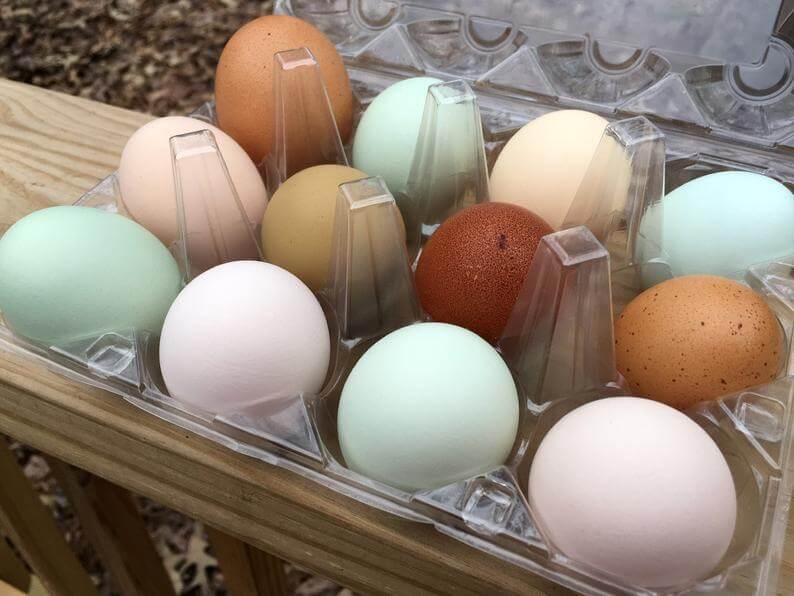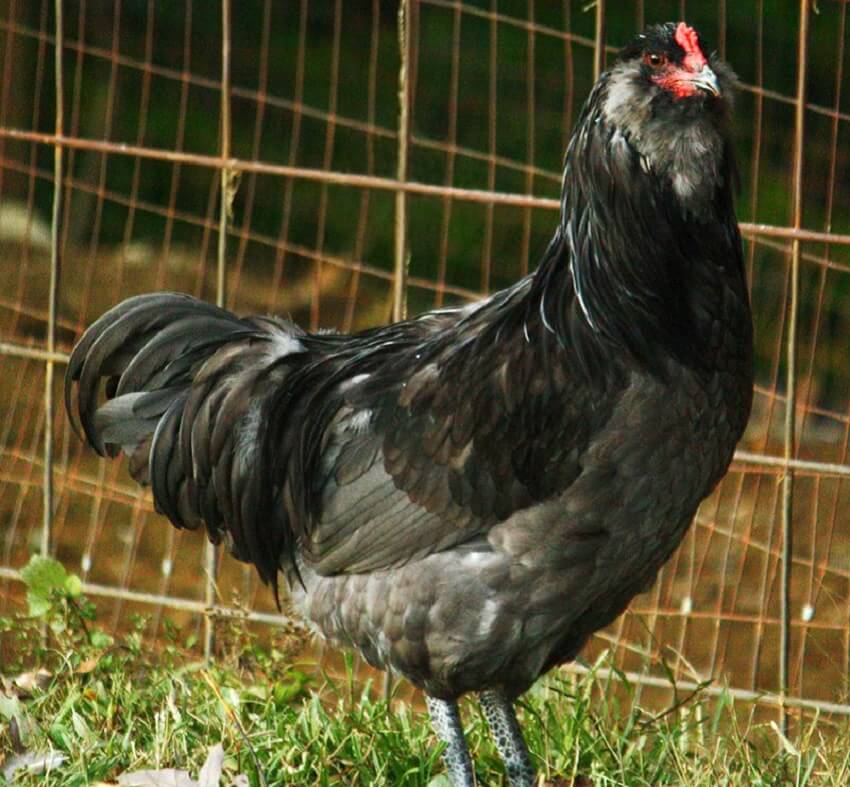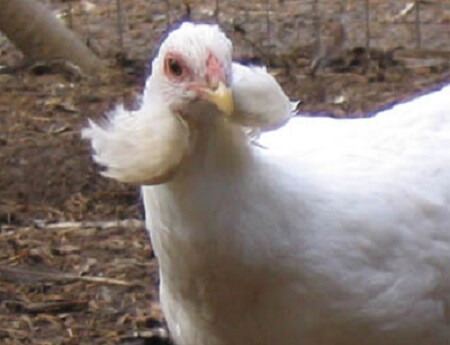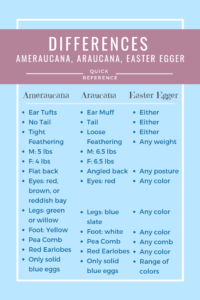Are you looking to add some beautiful colored eggs to your egg basket? There are many chickens that lay colored eggs, but not all breeds are created equal.
Several breeds of chickens lay blue eggs or blue-tinted eggs. Some breeds may lay a white egg that is tinted blue. If you are looking for colored eggs that are not brown or white, this is the place to learn about the best breeds for colored eggs.
Learn how to tell the difference between these “blue” egg layers.
What Chickens Lay Green, Blue, Pink, or Olive Colored Eggs? There are only two chicken breeds that produce a blue egg. The Ameraucana and Araucana chickens both produce a blue egg. The original “blue gene” comes from the Araucana chicken, which was bred into the Ameraucana chickens. In addition, there are several mutt breeds that produce a lighter blue or a green-tinted egg. Sometimes those crossbreeds are given the name of “Easter Egger” which isn’t actually a breed. It’s branding that loosely covers any chicken that lays a slightly colored egg.
If that isn’t confusing enough for consumers, many hatcheries take the Ameraucana or Araucana breed name and post it or variations of the spelling to sell their mutt breeds so it looks like the pure breeds. They may also create fake breed names and sell them as “rare” breeds when they are actually only Easter Eggers- crossbreeds that have distant ancestry to the Ameraucana or Araucana chickens.
What Chickens Lay Green Eggs? Chickens that lay green egg are bred by crossing a descendant of an Ameraucana chicken blue egg laying chicken with a brown egg laying breed. The blue gene may be strong if the parents were closely descended from real Ameraucana chickens, or it might be a very weak gene that results if little blue coloring.
The resulting chicks lay a muted egg color that is referred to as green or olive-colored, depending on the marketing of the hatchery. Some of the names used for green egg layers include Starlight, Bluebell Egger, or Olive Egger. None of those are actual breeds as accepted by any poultry standard.
Plus Silkie chickens are known to lay a greenish tinted egg.
What Chickens Lay Pink Eggs? The pink egg is another name for a faded brown egg layer. Common brown laying breeds that are said to lay pink eggs include Silkie chickens, Easter Eggers, Langshan, Australorps, Plymouth Rocks, Asil, Barred Rocks, and Light Sussex.
Most of these “pink” egg layers are classified as actually laying a light brown or a tan egg. The pinkish hue comes from a natural bloom that individual chicken apply over their egg. It can also come from the lighting when a photo is taken.
What Chickens Lay Brown Eggs? Dozens of chicken breeds lay at least a tan or light brown egg. Generally speaking chickens with red ear lobes lay a brown egg. Five chicken breeds are known to lay a dark brown egg. Dark brown egg layers are Barnevelder chickens, Empordanesas, Marans, Penedesencas, and Welsummer chickens. The eggs of these breeds are a terracotta, rich, deep brown. For more information check out Part II, Which covers the chicken breeds that lay dark eggs.

Choosing the right chicken breed can be difficult. Many people purchase chicks because they are advertised as blue egg laying chicks, but then they lay a pale blue or a green colored egg, leaving them disappointed. Continue reading to find out how to choose chicks that will lay blue eggs.
The more vibrant and clear your eggs are, the more you can sell them for at the market and the more fun you will have!
The Ameraucana Chicken Is Unique Among Chicken Breeds
The Americana is a crossbreed between the Araucana and the America chickens. They are often confused with Araucanas because they carry the blue-egg gene of Araucanas, but they aren’t as rare as Araucana chickens are.
Also, be aware that there isn’t such a breed as Americana or Americauna. That is a “breed” that is used for Easter Eggers and is used to imply it’s an Ameraucana when it isn’t.
Ameraucana’s became a breed in the 1960s. They were admitted into the American Poultry Association in 1984. Because of that, they are not officially considered heritage chickens. Heritage chickens must have been admitted prior to 1950. However, because of the old genetics of the breed, some people consider them heritage chickens.
Araucanas have a lethal gene that keeps the mortality of baby chicks high. As a result, Ameraucanas were bred to keep the blue egg gene, but get rid of the deadly gene.
In some countries, such as the United Kingdom and Australia, Ameraucana and Araucanas are considered the same breed.
Ameraucana Eggs Are A Lovely Blue Color
They are used for both meat and eggs. The roosters grow to about 6.5 lbs (2.9 kg). Hens grow to 5.5 lbs (2.5 kg).
Ameraucanas are late egg layers but lay a moderate amount of blue eggs. They will lay between 150-200 blue eggs a year. That means about 3-4 eggs a week on average.
Hens don’t mature until about 5-7 months. They don’t go broody often.

What Do Ameraucana Chickens Colors Look Like?
Ameraucanas have a pea comb, blue eggs, and white foot bottoms. They also have earmuffs and a beard instead of ear tufts. That makes their faces look a bit puffy- like they just came from the dentist!
Tails are carried at a 45-degree angle. Their eyes are a reddish bay color. Legs and feet are a blue slate to black color.
There are several color varieties including black, blue, blue wheaten, brown-red, buff, silver, wheaten, and white. Their feathering is loose.
You can usually get them through breeders and a few hatcheries.
Some local farm supply stores will carry Ameraucanas, but if they are priced like normal chicks, then they aren’t true Ameraucanas but are Easter Eggers with an Ameraucana influence. Ameraucana chicks are two to three times the price of a regular egg chick.
Caring For Your Ameraucana
They are very cold hardy and don’t get frostbite as easily as some chicken breeds. They are less heat-hardy. That means you will need to provide shade and plenty of water during the summer months.
They are easier to breed and hatch than Araucanas and don’t have the high mortality rates of their close cousins.
They don’t like captivity but will tolerate it if there’s enough room per chicken. 4 feet in a coop is ideal, while 10 feet per chicken is ideal in a chicken run.
The Ameraucana is rare, but not as rare as Araucanas. Ameraucanas are gentle birds that tame easily. They are a fun bird for a family to raise, but it isn’t a lap chicken. It is usually in the middle of the pecking order, neither the calmest or aggressive bird in the flock.
They can live 10 years or longer, depending on diet and it’s individual genetics. Plus, that long of lifespan is dependant on protection from predators!
| Climate | Personality | Use | Size | Eggs/ Yr | Brooder | Forages |
| Hot & Cold | Friendly
Flighty | Eggs | F: 4 lbs
M: 5 lbs | 180 | Yes | Yes |
- Blue Eggs
- Good Layers
- Semi-rare
Araucana Chickens
Araucanas originated in Chile. They are often lumped together with Easter Egg chickens and Ameraucanas but are a separate breed.
Araucanas come from two very old chicken breeds that are found in Chile. The Collonca and Quetero breeds were old breeds when the Spanish invaded Chile. The resulting offspring of those breeds is an Araucana.
True Araucanas are rare. That’s because they have a fatal gene that causes a high mortality rate in the unhatched chicks. This keeps Araucanas very rare. Ameraucanas are the result of breeding Araucanas to other breeds. They retain the blue egg gene but don’t have the lethal gene of Araucanas.
The Appearance of Araucana Chickens:
I love the appearance of Araucana chickens because of their adorable tufted ears, which are visible on the day they hatch. Some hens may have only one tuft. They don’t have tail bones, are rumpless and feature tight feathering with a pea comb on top their heads.
Some breeders lump Araucanas and Ameraucanas together, but Ameraucanas are actually a cross-breed of Araucanas and the Americas. Easter Eggers are a hybrid (and not a real breed), but Araucanas are considered a heritage breed.
Araucanas were accepted into the American Poultry Association in 1976. Most Araucanas will live for more than 10 years. Araucanas are a very old breed. Crossbreeds of the Araucana, including the Ameraucana, lay lighter and lighter blue eggs as each generation progresses.
Araucanas Are Loved For Their Solidly-Blue Eggs
Araucanas are smaller than Ameraucanas. The roosters grow to 5 lbs (2.26 kg) and Hens grow to 4 lbs (1.81 kg).
They mature quickly and lay about 260 blue eggs a year. That’s about 4-5 eggs a week. Hens can be broody and are great mothers.
The shells are blue all the way through, not just on the outside. Although blue eggs were once looked upon with suspicion, they are now widely popular.
If you have an “Araucana” that lays green or olive-colored eggs- then you have an Easter Egger- a mutt chicken with some Araucana lineage, but not purebred.
Marketers advertised blue eggs as healthier for you than white or brown eggs, which isn’t true- they have the same nutritional value, but it made the public more willing to eat blue eggs.
Now, blue eggs are desired for the beauty and variety they bring to a basket of eggs.

Araucanas are rare and you won’t find them at a hatchery. That’s because the fatal gene makes it so that only 25-50% of the eggs will hatch. If you want to raise them, you’ll need to get them from a breeder with a good reputation. Otherwise, you are likely to get an Araucana cross-breed instead of a purebred Araucana.
Caring For Your Araucana Chickens
Even though they are rare, they are not fragile. Araucanas are very strong birds. They are pretty hardy to most chicken diseases and aren’t specifically susceptible to any specific diseases.
They do very well in a free-range environment. Still, they need protection from predators. This can be provided by cooping free-range birds at night or via a chicken tractor.
They are tough birds and are somewhat flighty. Even so, they do not do well in confined, small spaces, but will do well in a coop that provides enough space.
They are friendly, if raised from a chick, and also very active. Although they aren’t a lap chicken, they do well as a pet and in a backyard where they can run around!
Araucanas do well in any climate, but they are better suited for colder climates. They do come from the highlands of Chile after all!
| Climate | Personality | Use | Size | Eggs/ Yr | Brooder | Forages |
| Hot & Cold | Friendly
Flighty | Eggs | F: 4 lbs
M: 5 lbs | 260 | Yes | Yes |
Araucanas always lay blue eggs and can be ordered from breeders. They are also noisier birds.
- Solid blue eggs
- Extremely Rare
- Carries a lethal gene that kills 25% of chicks before they hatch
Easter Egger, Americana, Americauna
The Easter Egger isn’t a recognized breed. It is actually a hybrid breed that is a cross between one of the blue egg chickens (the Ameraucana or the Araucana) and another chicken.
Easter Egger is a marketing ploy for the colored eggs. Easter Eggers are a mutt chicken and not a real breed.
Because Easter Eggers aren’t a real breed, there isn’t a lot of uniformity among different chickens. The characteristics can vary quite a bit.
The main characteristic of an Easter Egger is that they lay colored eggs. They can lay blue, green, olive, or even pink colored eggs.

Easter Egger- Anything goes!
As a result, nearly any cross of Ameraucanas, Araucanas and other chickens will be called an Easter Egger. Hatcheries or farm stores who have Easter Eggers often try to pass them off as Ameraucana, but the spelling will be wrong. `
They are usually raised by homesteaders for their multi-colored eggs.
| Climate | Personality | Use | Size | Eggs/ Yr | Brooder | Forages |
| Depends on Breeds Used | Depends | Eggs | Depends | Varies
180-200 | Usually | Yes |
- Not a breed- Mutt breeds
- Lots of variances in color of eggs
- Wide variety in the temperament of chickens
My Favorite Chicken and Duck Supplies
This list contains affiliate products. Affiliate products do not cost more but helps to support BestFarmAnimals and our goal to provide farm animal owners with accurate and helpful information.
Manna Pro Oyster Shell keeps eggs strong. Before I gave my chickens oyster shell, I had the oddest eggs, many with weak and irregular shells. Now, I don’t have an issue.
Layer Feed by Manna Pro. I like pellets rather than crumbles as my chickens eat them better and less gets wasted or scavenged by rodents. A good layer feed makes the difference in hens laying many more eggs.
My chickens love this mealworm treat, which gives added protein, something that’s great during molting and winter months.
There are many ways to feed and water your chickens. I like this food and water setup the best because it reduces waste, saves me time feeding and watering, and keeps the food fresh longer. Except, in the winter, I use a heated waterer. The only problem is the heated waterers need to be replaced every few years.
I love this chicken veggie hanger. It makes it easy to give your chickens produce from the garden and keep them occupied in the winter with a fresh head of lettuce.
These chicken toys are a hoot! They will help curb bullying and keep your chickens active, especially in the winter when hens tend to get more lethargic.
Differences Between Ameraucana, Araucana, & Easter Eggers


